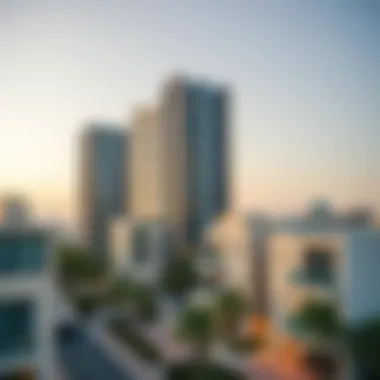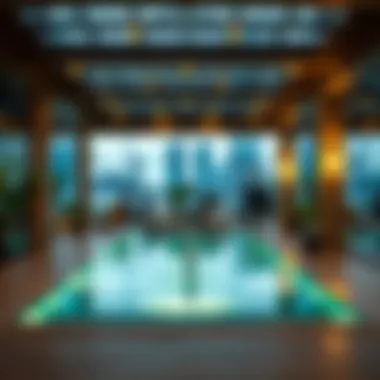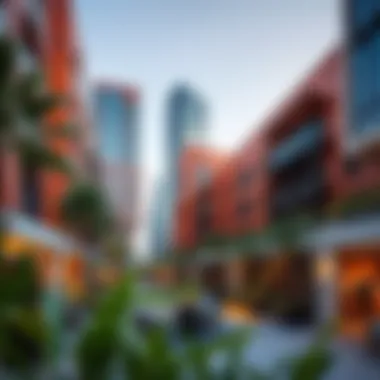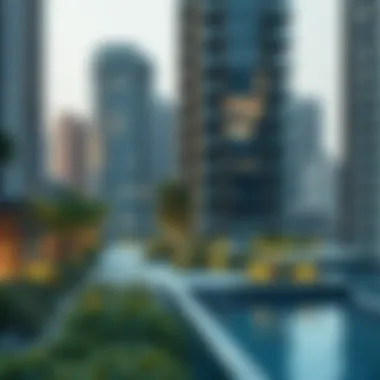Urban Nest Dubai: Exploring Modern Living Concepts


Intro
The charm of Dubai, known for its towering skyscrapers and luxurious lifestyles, has drawn attention from around the globe. Amidst this fast-paced urban environment, the concept of 'urban nesting' emerges, carving out a unique niche for contemporary living. Residents, investors, and visitors alike are increasingly looking for spaces that foster not only comfort but also community and sustainability.
This article aims to shed light on what makes urban living in Dubai distinct. We will delve into the architectural innovations that redefine living spaces, the amenities that cater to modern lifestyles, and the social fabric that connects diverse communities. Additionally, we will discuss the investment landscape, revealing trends and insights vital to understanding the future of real estate in this vibrant city.
As we embark on this exploration, understand that urban nesting is not merely a trend but a reflection of evolving societal needs. It redefines our relationship with the spaces we inhabit, blending individuality with collective living. Through our narrative, readers will gain a comprehensive understanding of urban nesting in Dubai, including its benefits, current market dynamics, and what the future holds.
Let’s begin by examining the current market trends that shape the property landscape in Dubai.
Defining Urban Nesting in the Context of Dubai
The modern concept of urban nesting in Dubai presents a fascinating glimpse into the intricate way people are integrating their lives within the city’s ever-evolving fabric. A blend of architectural innovation and lifestyle choices, urban nesting encompasses more than just real estate; it embodies a lifestyle anchored in community, sustainability, and the vibrancy of urban living.
Understanding this concept is crucial because it directly impacts various stakeholders, from investors and developers to homeowners and city planners. Urban nesting isn't merely about physical dwellings; it concerns how spaces are designed to foster connection, convenience, and wellness. It highlights the importance of creating environments that support social dynamics within diversity.
Understanding Urban Nesting
Urban nesting can be defined as a holistic approach to living in urban environments, focusing on maximizing both individual and collective experiences. It refers to the idea that residents can cultivate meaningful connections and thrive in their surroundings. In the wake of rapid urban growth, Dubai has emerged as a prime example, showcasing how contemporary living integrates housing, public spaces, and community engagement.
The benefits of urban nesting are multi-faceted:
- Community Engagement: Fosters connections among residents, encouraging communal activities that build relationships.
- Convenience: Prioritizes easy access to amenities, reducing reliance on transport and enhancing sustainable living.
- Diversity: Welcomes individuals from various backgrounds, creating a tapestry of cultures and perspectives in shared spaces.
A prime example can be seen in Dubai's Downtown area, which balances residential, commercial, and public spaces, allowing for interaction among inhabitants. This design approach makes urban nesting more viable, as it nurtures a sense of home while facilitating experiences in a bustling city.
Historical Evolution of Urban Spaces in Dubai
Dubai's urban landscape has undergone a remarkable transformation over the past few decades. Once known primarily for its oil reserves, the city has developed into a global hub for business, tourism, and culture. This evolution has had a significant impact on how urban spaces are envisioned and constructed.
Historically, spaces in Dubai were utilitarian, focused mainly on economic productivity. However, as the city expanded, urban planners began to recognize the need for more thoughtful designs that catered not only to industry but also to the human element within the urban environment. This shift can be traced back to the early 2000s, when the government began investing heavily in infrastructure and community-oriented developments.
The transformation can be summarized as follows:
- Traditional to Modern: Early urban spaces were focused on functionality, while contemporary developments emphasize aesthetics and livability.
- Integration of Green Spaces: Newer projects often incorporate parks and recreational areas, addressing the importance of nature in urban settings.
- Smart City Initiatives: Innovations in technology are making urban living more dynamic and efficient, reflecting contemporary needs.
As a result, urban nesting in Dubai reflects not just the houses and buildings but also embodies a community spirit shaped by history, economics, and culture. The city's unique blend of traditional values and modern conveniences signifies a new era of urban living that is both grounded and aspirational.
"Urban nesting is not just about where you live, but how you live in relation to others in an ever-changing cityscape."
The discussion of urban nesting not only helps investors and developers make informed decisions but also encourages a guided approach to creating sustainable living spaces that enhance the quality of life for all residents in Dubai.
Architectural Trends Shaping Dubai's Urban Landscape
In a city where the skyline is continually changing, understanding the architectural trends in Dubai isn’t just about aesthetics; it's crucial for investors, developers, and residents alike. Dubai has become an icon of modernity, blending traditional influences with cutting-edge technology. As this metropolis evolves, the architectural decisions made today will undoubtedly shape the urban environment of tomorrow.
Contemporary Architectural Styles
Modern architectural styles in Dubai showcase a blend of innovation and functionality, tearing down the conventional walls of design. From the stunning curves of the Burj Khalifa to the intricate lattice work of the Al Hamra Tower, each building tells a different story.


But what exactly sets these designs apart? For starters, they often fuse local culture with global trends, which provides a unique identity to the buildings. Consider the Dubai Opera House, where inspired design meets practicality; its flowing lines mimic the movement of waves, reflecting the surrounding waters of the Arabian Gulf.
The integration of smart technology further sets Dubai's architectural scene apart from others. Contactless systems, efficiency management, and automated homes are no longer visions of the future but are becoming the norm. This forward-thinking allows for a dynamic lifestyle that suits the diverse population of the city.
Also, sustainability is finding its way into these contemporary designs, as the drive for environmentally-friendly practices continues to influence architects’ visions. Some newer buildings have integrated features like vertical gardens and photovoltaics, which not only add beauty but also combat the harsh desert climate while reigniting discussions about conserving nature in urban settings.
"In Dubai, the future is architected not just for today but for generations to come."
Sustainable Design Practices
Sustainability is the name of the game when it comes to urban development in Dubai. Architects and developers are now grasping the importance of designing spaces that minimize environmental impact. This is crucial, not just from a regulatory standpoint but also for the sake of societal responsibility.
Some key sustainable design practices gaining traction in Dubai include:
- Energy-efficient Technologies: More buildings are being designed with energy-saving materials, resulting in lower utility costs and reduced carbon footprints. Glass canopies that minimize heat intake or smart tinting systems are some examples.
- Water Conservation Systems: With water being a precious resource, modern structures have started utilizing greywater recycling systems or rainwater harvesting mechanisms. This not only conserves water but also helps cut costs in the long run.
- Public Green Spaces: Urban planners realize the need for green areas where residents can relax and socialize. By integrating parks, gardens, and living roofs, developers are making urban life more bearable.
- Adaptive Reuse: Some initiatives focus on repurposing existing spaces into something innovative rather than demolishing them entirely. Adaptive reuse preserves the old while accommodating the new, contributing to a richer urban tapestry.
Through these ongoing trends, Dubai is carving itself a niche as a leading example of how a city can grow, evolve, and thrive—all while maintaining its commitment to sustainable living. Such foresightedness bodes well, not just for investors looking for new opportunities, but also for the hundreds of thousands who call this remarkable place home.
As we turn our gaze toward the future, the architectural choices made today in Dubai will set the trajectory for urban nesting tomorrow— blending convenience with sustainability for a truly harmonious living environment.
Lifestyle Amenities in Urban Dubai
In a burgeoning metropolis like Dubai, lifestyle amenities play a crucial role in shaping the urban experience. The importance of these amenities extends beyond mere convenience; they contribute significantly to the quality of life for residents, strengthen community bonds, and enhance the city's appeal to both local and international investors. The array of cultural, recreational, and health facilities available in this vibrant city provides a unique backdrop for contemporary living, which is central to the Urban Nest concept.
Cultural and Recreational Facilities
Cultural and recreational facilities in Dubai are more than just places to unwind; they are spaces that foster an enriched lifestyle. The city hosts an eclectic mix of cultural centers, museums, and galleries, such as the Dubai Opera and the Louvre Abu Dhabi, which attract visitors and residents alike. These venues not only provide entertainment but also promote cultural dialogue and appreciation among a diverse population.
Public parks and waterfronts like Al Qudra Lakes and the Dubai Marina walk also contribute to recreational options, allowing residents to engage in outdoor activities. Here, you can enjoy jogging, cycling, or simply soaking in the sun, helping to reduce the urban stressors that often accompany city living. With events frequently hosted in these spaces — be it food festivals or art exhibitions — there’s always something happening, which enhances community ties and offers opportunities for social interactions.
Other attractions, such as theme parks and sports facilities, cater to families and thrill-seekers, ensuring that all age groups find something to engage with. By blending cultural richness with physical activity spaces, Dubai encapsulates a lifestyle where leisure and culture thrive side by side.
Summary of Key Cultural and Recreational Features:
- Diverse Cultural Venues: Museums, galleries, and theaters that promote global arts and community engagement.
- Outdoor Spaces: Parks and waterfronts that support physical activities and social gatherings.
- Events and Festivals: Regular celebrations that enhance community interactions and cultural appreciation.
Health and Well-being Options
Health and well-being options in Dubai are extensive and cater to a wide range of needs. The emphasis on health is visibly integrated into community conversations, with several state-of-the-art fitness centers, yoga studios, and wellness retreats ensuring residents can prioritize their physical and mental health. Despite the fast-paced lifestyle prevalent in urban areas, Dubai offers a multitude of ways to slow down and focus on personal well-being.
Innovative healthcare facilities like the Dubai Health Authority and numerous private hospitals ensure that high-quality medical care is accessible. Comprehensive wellness programs are also gaining traction, blending holistic and traditional medicine to support residents' overall well-being. This focus extends beyond the physical, with mental health resources undergoing expansion, fostering an environment that underscores care for the mind as well as the body.
Moreover, initiatives focusing on healthy eating—such as organic cafes and farmer's markets—are becoming increasingly popular, aligning with global wellness trends. These accessible, health-conscious food options not only promote healthier lifestyles but also support local agriculture, creating a sustainable ecosystem.
Key Features of Health and Well-being Facilities:
- Fitness Centers and Studios: Varied options for physical activities, including gym facilities and specialist studios.
- Healthcare Institutions: Diverse medical services focusing on both traditional and alternative health approaches.
- Healthy Food Options: Increased availability of organic and health-conscious eateries, contributing to nutrition awareness.
"A city that invests in its citizens' health and well-being lays the groundwork for sustainable urban living."


Thus, the vast array of lifestyle amenities in urban Dubai is a telling sign of a city that listens to its residents and adapts to improve their experiences. The seamless integration of cultural, recreational, and health-focused elements significantly enhances the quality of urban life, making Dubai not just a place to live, but a place to thrive.
Community and Social Dynamics in Urban Nesting
Urban nesting goes beyond just physical living spaces. It's fundamentally interwoven with community and social dynamics, which shape how residents experience their environment. Understanding these dimensions is critical for grasping the full essence of contemporary living in Dubai. Community dynamics foster collaboration, support, and understanding within diverse populations. They are key to enhancing not just individual well-being but also the vibrancy of urban life.
Building Community Connections
Strong community connections are like the threads in a tapestry, holding together the varied pieces of urban life. In Dubai, where a melting pot of cultures resides, these connections are essential for both newcomers and long-term residents.
Here’s why building community connections is vital:
- Support Systems: Communities act as support systems for individuals and families. Whether it's sharing child care resources or offering emotional backing during challenging times, strong ties foster resilience.
- Cultural Exchange: Dubai is home to a multitude of cultures. Building connections among diverse groups leads to rich cultural exchanges, promoting inclusivity and understanding.
- Event Participation: Community events such as markets or festivals drive social engagement. These gatherings provide platforms for networking, learning, and sharing experiences.
Creating spaces that encourage community interaction is essential. Parks, community centers, and recreational areas can help facilitate these interactions, serving as common grounds where friendships blossom and alliances are forged.
Diverse Population and Inclusion
Diversity in urban settings like Dubai contributes significantly to social dynamics. The city's population includes individuals from various backgrounds, each bringing unique perspectives and contributions. The challenge lies in ensuring that this diversity translates into inclusion rather than segregation.
Inclusive urban environments can lead to vibrant and thriving communities. Here are some considerations:
- Accessibility: Urban planning must consider accessibility for all individuals, regardless of physical ability, age, or socioeconomic status. This ensures everyone can participate in community life.
- Representation: Involvement of different cultural groups in decision-making processes helps ensure that urban developments reflect the needs of the entire community rather than a select few.
- Education: Promoting understanding of different cultures through educational programs fosters respect and tolerance. This can include workshops, intercultural dialogues, and multicultural festivals.
The goal is to create a sense of belonging for all residents.
"A community that celebrates diversity truly thrives – it's where the magic happens, and everyone can find their niche."
Investment Opportunities in Urban Dubai
Investing in Dubai’s urban landscape presents a fascinating combination of reward and challenge. This section aims to bring to light the various factors that make Dubai a hotspot for real estate investment, detailing trends and dynamics that can benefit savvy investors, developers, and analysts alike.
Analyzing Real Estate Trends
The real estate sector in Dubai has been undergoing remarkable transformations, influenced by both local and global factors. The past decade has seen a rapid increase in property developments, with some unique projects that catch investors' eyes. Various aspects of the market merit close examination:
- Price Fluctuations: Prices have shown varying degrees, impacted by ongoing economic shifts and governmental incentives for foreign ownership. Despite periodic dips, long-term forecasts remain optimistic.
- Luxury Market Growth: High-net-worth individuals are turning their gaze towards Dubai’s sumptuous properties, contributing to an upward trend in high-end developments.
- Affordable Housing Demand: A notable shift towards affordable housing is evident. Developers are keen to cater to a growing middle-class demographic, marking a shift in the market.
In summary, understanding these trends can provide invaluable insights into making informed investment decisions. Investors need to stay on their toes, as today's booming segment may shift with new policies or economic indicators.
Understanding Market Dynamics
To truly grasp investment opportunities in Dubai, one must comprehend the underlying market dynamics. Various forces play significant roles in shaping this vibrant scene:
- Government Policies: The UAE government consistently rolls out policies designed to attract foreign investment. Initiatives like the 10-year visa for professionals and the easing of property ownership rules offer strong motivations for investors.
- Expo 2020 and Beyond: The global spotlight from major events such as the Expo 2020 has accelerated growth in the tourism and real estate sectors. Facilities constructed during this period are likely to enhance the appeal of the city as a long-term investment destination.
- Interest Rates and Financing: Changes in interest rates can heavily influence buying behavior. With competitive mortgage rates available, potential homeowners and investors have more opportunities to capitalize on the market.
"The best time to invest was yesterday. The next best time is now."
As Dubai continues to evolve, being informed about investment opportunities can place individuals and organizations ahead of the curve, ensuring they can harness the potential offered by this dynamic city.


For further reading and insights, check out Wikipedia on Dubai or explore market discussions on Reddit's real estate forum.
Challenges Facing Urban Development
Urban development in Dubai carries a unique set of challenges that cannot be overlooked. As one of the leading global cities, Dubai constantly strives toward progressive growth. However, this rapid urban expansion brings forth its own set of complex hurdles that demand careful navigation. Addressing these challenges is crucial not only for maintaining the quality of life for residents but also for securing the future viability of investments in the region.
Understanding these challenges helps investors, real estate agents, developers, and analysts to better evaluate opportunities and risks in the urban landscape. Moreover, with an ever-increasing population and a diverse demographic, ensuring that urban development meets the needs of the community is more important than ever.
Environmental Considerations
Environmental factors play a significant role in shaping Dubai's urban planning. The city's rapid growth often leads to concerns regarding sustainability. The geographical location poses its own challenges, as the region is hot and arid. Urban sprawl can exacerbate these problems, leading to heightened energy use and increased pressure on water resources.
In response, Dubai has been integrating various sustainable practices into urban development. Innovations in building materials, energy-efficient structures, and green spaces are being prioritized. Shifts toward solar power and newer waste management systems are making their way into new urban projects, reflecting a commitment to creating more sustainable living environments.
Some examples of this include:
- Green Building Initiatives: Regulations are in place that encourage developers to adopt sustainable building practices, leading to a lower carbon footprint.
- Smart City Technology: The integration of technology in managing urban utilities helps optimize resource consumption and enhances the overall quality of services.
- Community Green Spaces: Plans for parks and recreational areas not only improve the cityscape but also promote biodiversity and provide residents with much-needed respite from urban clutter.
"To achieve a sustainable urban environment requires the participation of all stakeholders, from the government to citizens."
Socioeconomic Factors
Socioeconomic factors present a different yet equally important challenge to urban development in Dubai. The demographic diversity is a double-edged sword; while it fosters a vibrant culture and economy, it also brings complexities in terms of social integration and equality. The influx of expatriates, coupled with an increasing local population, can lead to disparities in access to services and housing.
Understanding the financial dynamics at play is crucial for creating inclusive urban spaces. As property prices soar, the risk of gentrification and exclusion of lower-income groups becomes more pronounced. The government has undertaken initiatives to provide affordable housing options and community services to tackle this disparity.
Key elements include:
- Affordable Housing Projects: These aim to create mixed-income communities where people from various backgrounds can live harmoniously.
- Employment Opportunities: Sustainable job growth for all demographics is critical. This is not just about creating jobs but ensuring they are accessible to all segments of society.
- Social Infrastructure Development: Enhancing healthcare, education, and public amenities helps foster social cohesion, making every community member feel valued and included.
By addressing these socioeconomic factors thoughtfully, Dubai can ensure not only its own growth but also the well-being of all its residents.
Future of Urban Nesting in Dubai
The concept of urban nesting in Dubai is not just about finding a roof over one’s head. It's a tapestry of innovation, sustainability, and community connection. The future of urban nesting here hinges on several pivotal elements that not only enhance the quality of life but also cater to an ever-evolving market landscape. For investors, developers, and homeowners alike, the stakes are high, and understanding these future trends is essential for making informed decisions.
Emerging Trends and Innovations
One cannot discuss the future of urban nesting without bringing into focus emerging trends and innovations. The integration of smart technologies into residential spaces is at the forefront of this evolution. Smart homes equipped with Internet of Things (IoT) devices allow residents to control lighting, temperature, and security systems from their smartphones. This push toward smart living is about more than convenience; it’s about energy efficiency and sustainability.
Additionally, eco-friendly building practices are becoming quintessential in new developments. As local authorities encourage green architecture, innovative materials that minimize environmental impact are gaining traction. Imagine a high-rise built entirely from recycled materials or utilizing solar panels in every unit to produce renewable energy.
Some of the notable examples include the Dubai Sustainable City project, which sets the standard for green living. The emphasis on sustainability resonates with a growing segment of the population that values environmental stewardship.
More apartments now feature community gardens, rooftop farms, and shared workspaces, promoting a sense of community. The flexibility of space usage allows homes to adapt to evolving family needs, reflecting a more modern, dynamic lifestyle where the distinction between living, working, and socializing becomes blurred.
Vision and Beyond
Dubai’s Vision 2040 represents a strategic plan tailored to reshape urban living for the next couple of decades. The government aims to make the city more livable and inclusive, catering to both residents and tourists. Among its core missions is to enhance the quality of urban environment, which includes increasing public spaces, integrating nature into urban settings, and promoting bicycle-friendly routes.
Under Vision 2040, the emphasis on affordable housing and mixed-use developments comes as a response to the rising costs of real estate, ensuring that urban nesting remains accessible to a diverse range of inhabitants. This vision proposes the introduction of public transport links that connect residential areas with commercial districts.
The idea is clear: to create a city where everything is within arm's reach, reducing congestion while promoting a greener urban lifestyle. This multifaceted approach aims to foster social cohesion, bridging cultural gaps among the city's diverse population. As the city evolves, it’s poised to redefine urban living within a framework that is not only functional but also satisfying for its residents.
“The future of urban nesting in Dubai goes beyond architectural marvels; it extends to creating communities that thrive on collaboration and sustainability.”
In summary, the future of urban nesting in Dubai is threading innovation with tradition, enriching lives while remaining attuned to global trends. Investors, developers, and agents should remain vigilant to these adaptive changes as they shape the landscape of urban living in one of the world’s leading cities.







